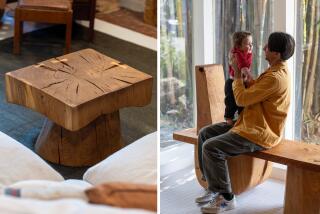He Turns Wildlife Art Into Something More Than a ‘Sportsman’s Craft’ : World-Class Carver Transforms Pieces of Wood Into Flights of Fancy
- Share via
STAHLSTOWN, Pa. — Larry Barth is a heavyweight in a world where a gram of wood shavings fluttering onto his workbench can represent a hard day’s work.
He carves birds.
The sharp steel edges of Barth’s chisels bite into blocks of basswood and tupelo and find songbirds, predators and game birds that possess an air of movement. With that, he is helping to transform wildfowl carving into something more than a sportsmen’s craft.
Wildlife Art
“There’s a tremendous interest in wildlife art and probably has been for the past 10 or 15 years,” said Sam Dyke, immediate past president of the Ward Foundation, a nonprofit arts and education organization that sponsors an international competition in Ocean City, Md. “But it’s certainly not the kind of art that endures. It’s maybe calendar art. It’s not generally regarded as fine art. Larry’s work is.”
Barth, 31, works in a quiet, well-lighted shop in his home among hardwood forests and manicured farms in the Laurel Mountains, 50 miles east of Pittsburgh.
He is usually at his bench from 8 a.m. until 5 p.m., breaking for lunch and supper. He often returns to work when the hubbub of evenings with his wife, Linda, and their two young children dissolves into night.
“For fun I go out and do brute force things that don’t require a lot of precision--splitting firewood or building stone walls around the place.
“That feels really good after a day of removing a gram of wood from feathers the size of your fingernail.”
Barth prefers to carve songbirds, but is getting more mileage out of birds of prey.
“I’m not into ducks,” he said.
$319,000 Decoy
Some people are. A decoy of a pintail carved by Elmer Crowell of Massachusetts was auctioned several years ago for a record $319,000.
That was probably an “aberration” in an emerging and unsettled market, said Curtis Badger, editor of Wildfowl Art, the Ward Foundation’s quarterly magazine.
The Ward Foundation purchases each year’s winning entry for $20,000, but antique decoys are where the big money is.
“You have to do what you know,” Barth said. “What I know about are songbirds, upland game birds and birds of prey.”
Conducts Detailed Studies
Before lifting a knife or a chisel, Barth studies the bird he plans to carve. He reads books, examines pictures and museum exhibits and watches them in life, often at a bird-banding station that Carnegie Museum operates half a mile from his house.
After the drawing comes the critical rendering in clay.
“Once I have the clay model done, as far as I’m concerned, the piece is done,” he said. “The toughest decisions I make are in the clay. After that it’s just technical execution . . . the noodling out of the detail.”
Carving the wood can be grueling. Gluing blocks of wood together and roughly shaping them with chisels is followed by the tedium of carving the feathers, detailing each down to the space between the barbs.
“I’m dealing with the top one-sixteenth of an inch of the wood,” he said.
He chars the wood with an electrically heated blade to create the distinct, hard feathers of the tail and wings, and he grinds the wood to create the loose, soft feathers of the body.
Back-to-Back Titles
Barth established himself as a new force in the field with back-to-back world-class titles at Ocean City.
He won in 1985 with a formidable and confident snowy owl, at rest, smugly clutching a limp Bonaparte gull. Barth repeated the next year with a pair of airborne terns, one flaring its tail and wing tips, the other tucking a wing and arching its tail as the two birds bank left in tight formation.
Most recently, Barth received a commission from the prestigious Leigh Yawkey Woodson Art Museum in Wausau, Wis.
The Woodson Museum, a general art museum with a specialty collection of wildlife art, is paying Barth an undisclosed sum for a carving of his choice. Indulging his preference for robust, chunky birds, Barth is carving a tern being chased by two jaegers, the black-hooded bullies of the seashore.
‘A Maverick, a Master’
“He’s showing situations that seem almost impossible to present, given the medium,” said Kathy Foley, director of the Woodson Museum. “Larry is a maverick, a marvel, a master. He’s carved circles around people who’ve been carving longer than Larry’s been alive.”
The Woodson commission is the latest in a series of honors Barth has received since he jumped into the spotlight at age 21 with a family of great horned owls that won second place at the 1979 Ward competition.
Until then, he had carved in isolation, making his own tools and developing his own techniques after being drawn to the craft through his father’s interest in wood carving and his mother’s interest in bird watching.
Barth was in the ninth grade when he carved his first bird, a thumb-size attempt at a rufous-sided towhee.
More to Read
Sign up for Essential California
The most important California stories and recommendations in your inbox every morning.
You may occasionally receive promotional content from the Los Angeles Times.










